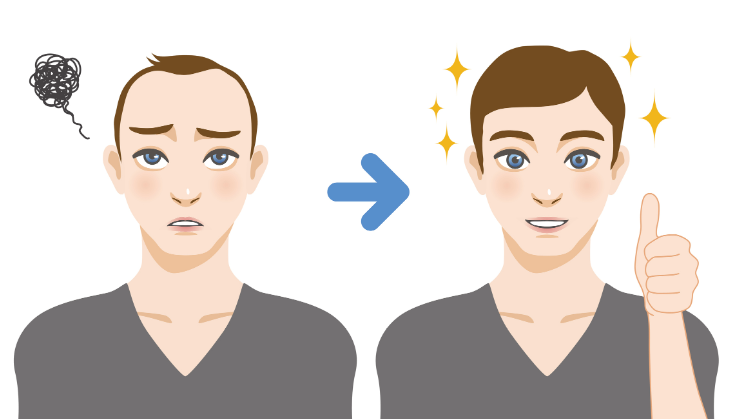Website Content for Hair Loss, Restoration and Replacement

Who is Losing Their Hair?
We take our full head of hair for granted when we’re young. Then one day, it suddenly seems we have either a bald spot at the back of the crown or widow’s peaks that rise higher and higher. Men seem to lose hair broadly, while women tend to see overall thinning, mostly across their frontal and temporal hairlines. In fact, statistics from a number of sources indicate that about 25% of men start to see hair loss as early as 21 with the percentage increasing to 66% by 35 and almost 85% for those 50 and over (American Hair Loss Association). Women are also not immune as almost 40% experiencing hair loss are women, with 50 percent experiencing the problem by the time that they reach 50. Women become particularly concerned about hair loss in their eye brows and eye lashes will for men, the problem is more focused on pattern baldness.
On average, we lose approximately 100 hair follicles per day. The total number of hair follicles on average is between 100,000 and 150,000, so 100 does not seem like many. However, as we age, the rate of growth of new hair also declines, according to WebMD. And with 10% of our hair follicles at rest at any one time combined with slower growth and hair loss, thinning areas will appear to increase in size.
What Causes Hair Loss in Men and Women?
Research and studies by organizations such as the American Hair Loss Association and the International Society of Hair Restoration Surgery have identified a wide range of factors that contribute to hair loss.
- Heredity and genes – It is estimated that due to DNA, approximately 30 million women and 50 million men experience hair loss.
- Hormones – the presence of DHT in the hair follicles can block the growth of new hair. DHTis an androgen that is thought to cause hair follicles to miniaturize, and this contributes to pattern baldness in men and women.
- Medical conditions -.there are also a series of medical conditions that can contribute to hair loss. These include: anemia, lupus, and hypothyroidism. Medications such as anabolic steroids, blood thinners, lithium, antidepressants and beta blockers for high blood pressure also can contribute.
- Diet – scientists have also identified a number of issues related to diet that can have an impact on hair loss, including too little protein, vitamin B deficiencies and too much vitamin A.
- Emotional and physical stress – severe stress can trigger telogen effluvium, which results in hair going into a shedding phase. This is usually related to a significant traumatic event such as surgery, car accidents, family tragedies or severe illness.
- Poor Hair Care Practices -.ranging from over stressing the hair with excessive use of hair dryers, pulling the hair too tight in a pony tail, braids and corn rows or using too many hair relaxants or other chemicals to treat the hair.
What Are Some of the Common Solutions for Hair Restoration?
Depending on the specific cause of hair loss, there are specific treatments available. The FDA has approved two treatments – one over the counter (Minoxidil) and another by prescription (Finasteride) – to address DHT, which shrinks hair follicles and impedes further growth.
- Rogaine (Minoxidil). To fight this form of hair loss, Upjohn released prescription-based minoxidil in 1988 under the trade name Rogaine, with FDA studies finding nearly 40 percent of men saw “moderate to dense hair growth on the crown of the head.” In 1992, a version for women hit the market, and in 1996, both were approved for over-the-counter use. It’s believed minoxidil widens blood vessels and opens potassium channels to allow more oxygen, blood and nutrients to reach the follicle.
- Propecia (Finasteride). In 1992, the FDA okayed finasteride for men after a study showed an 83 percent success rate in subjects who continued use for two years. In 1997, Merck released the drug as an ingestible pill under the brand name Propecia, which is shown to affect the anterior mid-scalp and crown regions specifically. Then, in 2002, dutasteride was brought to market as Avodart, which demonstrated a curtailing effect on androgenetic alopecia in each sex. Both drugs are available by prescription only and act as 5-alpha reductase inhibitors, which slow the creation of hair-loss agent DHT.
A number of new products have hit the market using these formulae or basic on proprietary botanical and natural ingredients. Some of the highest rated systems include Revivogen, Viviscal, Nutrafol and BallVic.
How Effective is PRP for Hair Restoration?
Our blood contains two different elements – red blood cells and plasma. The plasma contains white blood cells and platelets. Platelets are rich in growth factors. PRP is a three-step process by which a small amount of a patient’s blood is drawn (Step 1) and put in a centrifuge. Spinning the blood allows it to be separated, obtaining the platelet rich plasma (PRP) (Step2). The PRP is then placed in a syringe and injected into the area of thinning hair (Step 3) at the level of the hair follicle. Combining the PRP with thrombin or calcium chloride results in the production of growth factors (cytokines). By performing multiple injections about one half an inch apart in the target area, the PRP stimulates growth of existing hair follicles and generation of new growth. Each hair follicle can have multiple hairs growing from it. The PRP increases blood supply to the hair follicle and increases the thickness of the hair shaft as a result.
The standard protocol is for this less than one-hour procedure to be performed once a month for three months initially and then once every four to six months to continue the growth cycle. Information from realself shows that 73% of patients believe that it is worth it. Research from India indicates that average increase in hair growth experienced was approximately 30%.
Some medical practitioners have successfully combined adult stem stems obtained by purifying the patient’s adipose fat tissue obtained through liposuction to the PRP to make the process even more effective.
What Is SmartGraft Hair Transplantation?
Formerly, hair transplantation required that an extensive patch of scalp with hair be taken from the lower back of the head. Once the strip was surgically removed, the remaining skin was stretched back together and stitched closed. As you would imagine, this left a long scar at the closure line. Hair wasn’t able to grow there, so the scar was very visible, especially when doing things like swimming. Plus, the transplanted strip on the balding area didn’t look like natural hair growth. It looked more like a strip of sod.
Those days are over thanks to follicular unit extraction (FUE). In FUE, hair follicles are removed and transplanted one by one. While there are a number of different FUE devices (e.g. NetGraft, Artus, SmartGraft), Capily Institute recommends the SmartGraft device and procedure as it produces follicles with higher viability for the transplant. Why is this the case? The SmartGraft device allows all follicles to be collected, counted, stored in a sterile temperature-controlled and hydrated environment.
As each follicle is individually extracted it is sent through a tube where it is cleaned and kept in a climate-controlled environment to maintain hydration and viability while waiting to be transplanted. As it can take a few hours for the individual follicles to be harvested, depending on the extensiveness of the transplant procedure, other devices may allow the follicles to dry out, reducing their viability.
Would I Be A Good Candidate For Hair Transplantation?
Patients seeking FUE transplantation need to have an ample supply of functioning hair follicles on the lower back of the scalp. This is the area where the healthy follicles will be harvested for transplantation to the balding/thinning areas. These hairs from the back of the head (occipital area) are to be resistant to hormonal influences and subsequent balding.
How Is FUE Transplantation Done?
You’ll arrive in the morning and meet with the Hair Transplant team, who will describe the entire procedure for you again, and answer any new questions you might have.
You may be provided with a light sedative. Next, local anesthetic will be provided to the donor area at the back of your head.
Then the SmartGraft device is used to gently remove the individual hair follicles one by one from the donor area. Each follicle has from 1-4 hairs in it. The SmartGraft device enables the team to immediately collect, sort, count, and store each graft in a sterile, temperature controlled and hydrated environment prior to implantation. The SmartGraft system thus ensures a high graft survival rate.
After the desired amount of hair has been harvested, the transplant recipient area is then locally anesthetized. This is the area that you and the Hair Transplant Expert Team had marked together at the very beginning. One hair follicle at a time is transplanted using the device.
It first creates holes for the donor follicles. A scalpel isn’t needed for this step. The hairs are then inserted into these holes. The system ensures the hairs will be placed at the right depth and the correct natural angle. Your transplantation procedure will take around five to six hours. You will go home thereafter and may return to normal social life after 2 days.
What Are The Advantages Of The SmartGraft Method Of Hair Restoration?
SmartGraft has advantages over other restoration devices:
- It gives you better results in less time.
- It’s ideal for both men and women.
- SmartGraft has the highest hair viability rates on the market.
- It allows the implantation of hair grafts in just the right spots, easily.
- It can be used to harvest grafts from other parts of the body, such as the chest, back, and face, if needed.
- SmartGraft provides great results for eyebrows.
When Will The Hair Start To Grow On Its Own?
Your transplanted hair is very likely to fall out soon after the treatment over the next two to three weeks. This can be discouraging, but it is totally natural. This doesn’t mean transplantation failed; it simply is a reaction to the trauma of transplantation. The follicles that survive (usually around 90 percent) will then fully take and will return to the anagen (growth) phase in 3-4 months. As the anagen cycle continues, hair will grow naturally through these transplanted follicles.
Will My Hair Look Natural After Transplantation?
Fully functioning hair follicles are transplanted to your balding areas. As mentioned earlier, these occipital follicles are not susceptible to the reasons that caused your balding, so they will grow hair normally which will be your natural scalp hair. This new hair will thus be immune to future balding.
The Hair Transplant Team achieves the most natural results by ensuring to place the angle of the implanted hair in a natural way for each particular area and also taking care to follow the pattern of a natural hairline.
Recovery After SmartGraft Transplantation
Recovery is easy. There might be mild discomfort around the donor or recipient sites, and occasionally patients take a regular Tylenol for it. Both the donor sites and the transplant sites heal quickly and most people go back to work between 1 – 3 days
You may wash your hair in three days after your procedure. We’ll show you how to wash the transplanted area with water to keep the recipient area clean and to stop it from developing crusts on the implanted follicles; it’s important not to rub the follicles and not to use a towel to dry the area. And…. you are on your way to new youthful hair! Enjoy!






















